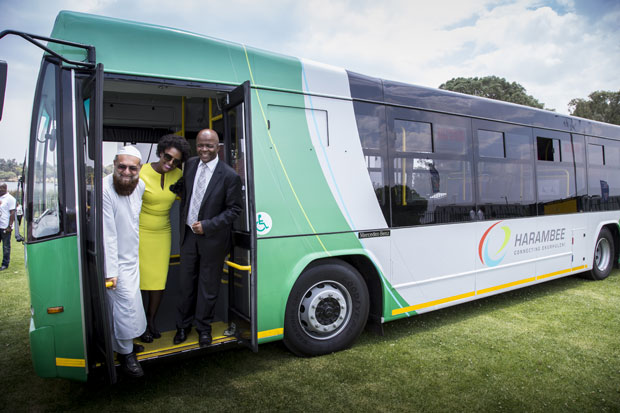New bus system for Ekurhuleni
New bus system for Ekurhuleni andileLocal government
From early next year, commuters in Ekurhuleni will move around in new state-of-the-art buses.
The new Bus Rapid Transit (BRT) known as Harambee is expected to carry more than three million citizens from across nine towns of the Ekurhuleni Metropolitan and to change the face of public transport and infrastructure in the region.
Harambee is a Swahili word meaning “pulling or working together in unity”.
“As the manufacturing hub and a gateway to the world, Ekurhuleni’s transport system needs to be elevated and made competitive as those of other airport cities in the world. Integrated transport is key in helping the city to get organised logistically in order to manage transportation of high value goods to the airport,” said Ekurhuleni Mayor Mondli Gungubele.
He said the new buses would bring comfort, safety and reliability to the people of Ekurhuleni.
“Working with our various stakeholders in the public transport sector, we have done extensive work to build the infrastructure and the order for the buses has already been placed.
 “Our people must know that their safe, comfortable and affordable movement remains one of our key priorities and has been since the establishment of Ekurhuleni in 2000.”
“Our people must know that their safe, comfortable and affordable movement remains one of our key priorities and has been since the establishment of Ekurhuleni in 2000.”
The new buses will connect the nine towns that make up Ekurhuleni, namely Benoni, Germiston, Springs, Kempton Park, Edenvale, Nigel, Brakpan, Boksburg and Alberton in a bid to overcome the problems created by apartheid spatial planning.
Construction of the Harambee BRT started in April 2014 on the complementary route between Tembisa Hospital and the Tembisa Civic Centre.
“The first phase, which is 56km, will run from Tembisa in the north via Kempton Park, OR Tambo International Airport and Boksburg, ending in Vosloorus in the south.
“The first phase will launch operationally in 2016 and the operationalisation of the entire project is projected for October 2017,” explained Gungubele.
The new system will be operated from a state-of-the-art traffic management centre in Kempton Park which will control all of Ekurhuleni’s transport services through CCTV cameras, vehicle tracking and navigation systems in the buses and at the stations.
“With regular travel times during peak and off-peak hours, passengers are able to plan their lives better and get to work, play and school on time.”
The BRT system was introduced as a means to enhance the standard of public transport and the quality of life for Ekurhuleni residents, which is also in keeping with the spirit of connecting Ekurhuleni.
The aim of the BRT system is to link different parts of a city into a network. Government wants to ensure that by 2020, most city residents are no more than 500m away from a BRT station.
BRT systems combine the best features of rail with the flexibility and cost advantages of road-based transport and have the added advantage of being easier and faster to build than a light rail transport system.
MEC for Roads and Transport Ismal Vadi said: “The key requirement for growth to the economy is good infrastructure as well as integrated transport system. The significance of Harambee is to bring cities together and we hope it integrates all elements of the communities it serves.”
MEC Vadi also announced that an intermodal facility would be built between Ivory Park and Tembisa to link up Rea Vaya and Harambee BRT systems.